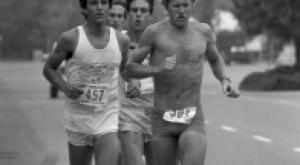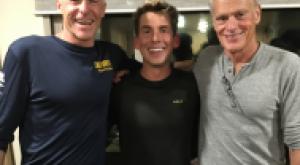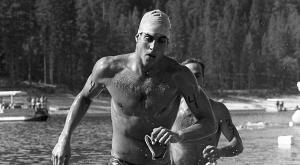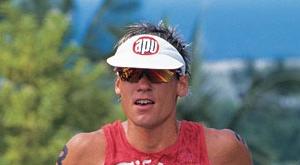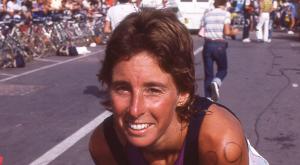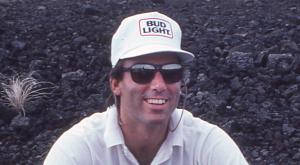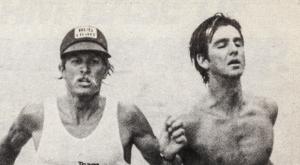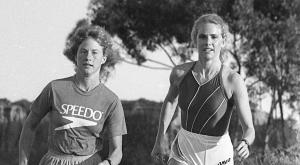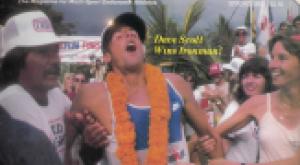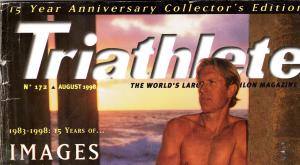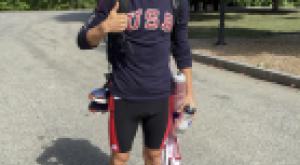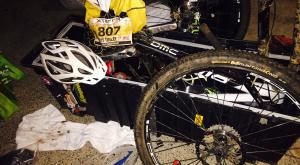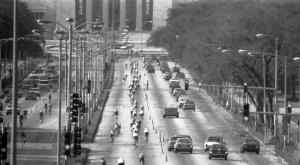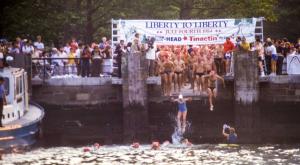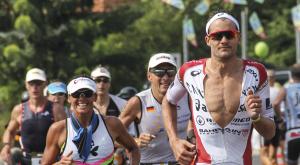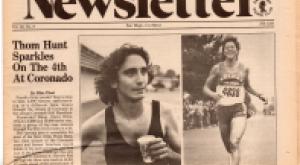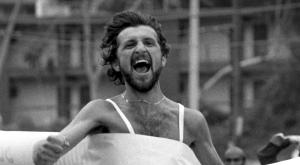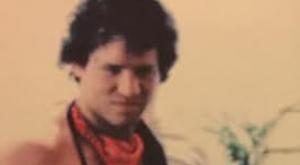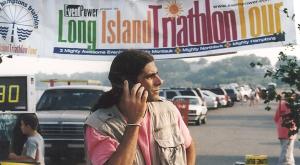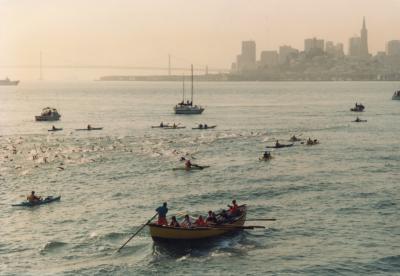
The boat escort has always and already been a part of the Escape experience. In ’91 Oakes and Co. organized a traditional whaling boat to keep the swimmer safes from cargo ships and white whales. Photo courtesy of Eric Gilsenan
“If the earth has a soul and Alcatraz Island is stuck in some geographical purgatory, it would all make sense, would it not? It could pay the penance of all those who had used this place for evil by itself acting like a bridge. -- S.Tinley, from The Alcatraz Swimmer’s Manual by Joe Oakes

The “Voice of the Escape” and 27 time escapee, Eric Gilsenan poses with 1989 winner, ST. Two good looking kids in simpler times with complicated afflictions to beat. (Courtesy of Eric Gilsenan)
“How many pounds of pressure do you want, ST?”
“Huh? Pressure? Not much at stake here, EG. Pretty relaxed about the event.”
“No, how many pounds of air pressure would you like in your bike tires?”
My friend, Eric Gilsenan, a 27-time finisher of the Escape from Alcatraz Triathlon, is working the gleaming floor pump like a jackhammer. The self-ordained “Voice of the Escape” looks at me across the pre-race day paddock as does someone who ponders the wandering mind of an old professor and questions whether they are lost, lazy or loopy.
“Oops. Sorry, Bro. Not sure. The gauge on my pump has been broken since ’99. Just let me give that rubber the squeeze test. I’m sure they’ll be fine.”
It’s the 2015 Escape from Alcatraz Triathlon—the 35th anniversary of this version of a storied event and I’m preparing to participate wholly in my first major triathlon since Kona 1999. I’m not sure what makes this event any more major than others over the past 16 years. I’d done a slew of Xterras and Wildflowers and CAF San Diego Triathlon Challenges, and had not missed our Tri Cal Tinley’s Adventures in its 20-year history. But those events mostly appropriated the feel of a post-career warm down, a value-added dénouement; that necessary parade lap that facilitates a winding down of the warrior. Pro athlete detox. Since Kona ’99, I had loved those local and regional gatherings for their methadone effect.
Then it was 2015 and I was clean.
“Hi this is IMG Action Sports and as a former winner of the event, we’d like to invite you to the 35th Anniversary of the Escape from Alcatraz Triathlon. And as a former winner we’d like to…” It was a formal invitation worth a formal reply if not an up close and personal consideration of the costs and benefits. IMG (International Management Group) was the original and was at one point, the largest sports representation firm on the planet. In recent decades, IMG Media (formerly TWI-Trans World International- IMG’s broadcast division) had helped the company move deeper into the sports event space. Management and ownership of the Escape from Alcatraz Triathlon had come when they acquired Golden Gate Productions (GGP) in 1998. James Leitz, Senior Vice President and Global Head of IMG Action Sports, suggested, “The Escape from Alcatraz Triathlon was a nice asset, but considered more of a media and content play that was at the core of GGP’s business. The Escape from Alcatraz Triathlon was great sports programming that combined legitimate athletic competition with great storytelling and a beautiful and infamous backdrop.”
IMG and I had done business together over the last three decades beginning in 1982 when Barry Frank, then head of TWI, had introduced himself to me in a smoky bar near the tiny town of Wanaka, New Zealand in the spring of 1982. Our business together had been lively, interesting, and profitable until two things happened: first, IMG’s founder, Mark McCormick died suddenly eight days before our scheduled in-dept interview, and second, I had opted out (at the last minute) from an IMG event in China when it was made clear that the title sponsor was a cigarette company. “You’ll never compete in an IMG event again,” I was told. But time and tide had buried those vagaries of commercial sport and here it was, 2015.
As both an historian and one of the birth fathers of the sport, my aversion to corporate gentrification in triathlon initiated cynicism if not hippie-radar. But the sport and I needed a platform to tell our history. IMG had re-awakened the capitalist in me; a place I had thought I’d escaped. But only when my hypocraphal checkbook showed more green than red.
It was a thoughtful though generic pitch. There was the standard two-free nights, VIP parking, in-room coffee et al. And then the best--as a nostalgic caveat, “if you would perhaps like to participate, free entry.” This clause landed in my recovered psyche somewhere between—you could do it and why would you do it? I was flattered but skeptical. Wary but wondering how I’d reawaken my dark and distant light of competition. The offer had stirred both the cynic and the silenced. Of course I’d want to compete. Or at least participate. The Escape from Alcatraz Triathlon—once labeled, “World’s Most Dangerous Triathlon”—has real history. So why the hell not?
The oldest trail running event in the U.S. is the Dipsea Trail Run. Begun in 1905 and held (nearly consecutively) on the second Sunday in June, the 7.4-mile run is a point-to-point scramble over ruggedly-handsome terrain. It begins in the quaint, Marin County town of Mill Valley, just north of San Francisco and ends in often fog-shrouded Stinson Beach to the west. To complete in the time and age-handicapped event is a kind of grail for the life-long trail runner. To run the Double Dipsea Trail, out and back, alone, 14.8 miles of misty redwoods, ankle-grabbing roots, and views into the next world, is a holy experience.
Similar feelings have been voiced by open water swimmers about the roughly 1.5 mile route from La Isla de los Alcatraces or the island of the pelicans--the name assigned to Alcatraz Island in 1775 by Spanish explorer, Manuel de Ayala—to the shores of San Francisco. Pelicans no longer nest en mass on this piece of water-bound rock. But people have been attempting to swim the channel since the U.S. military established it as a prison in 1861 to house Civil War prisoners. In the subsequent 29 years the U.S. Department of Corrections operated the prison (1934-1963), 34 different men in 14 attempted escapes failed to reach freedom (not inclusive of the never-found trio of Frank Morris, John Anglin, and his brother, Clarence). Potential escapees were often shot-on-sight by prison guards. No one could successfully escape The Rock; a lore propagated in popular culture by film, song, and verse.
The mythic challenge was more easily met by open water distance swimmers once the prison closed in 1963, facilitating public access to the island. And by the late 1960s when endurance sports began to creep into the athletic landscape, it became a regular subculture quest. To swim from Alcatraz Island to the mainland during that period, secretly, silently, was comparable to putting up a new route on Yosemite’s El Capitan or Half Dome out of the famous Camp 4. If you told anyone, the legend died before it became one.
It’s debatable who the first person was to actually swim from Alcatraz to the San Francisco shore. According to the San Francisco Chronicle, in one week in 1933, three women made the crossing. Seventeen year old, Anastasia Scott, Miss Doris McLeod, and Gloria Saglione--who made the interesting choice of swimming to the island--were all successful. Scott, a champion swimmer, made the crossing in 47 minutes. Neither, however, achieved what Mabel Green had accomplished in 1923 when she swam to the island, touched the shore and swam back to San Francisco.
Apparently, if the tides were right and the aquatic gods were smiling and you possessed enough body fat, the swim was doable. But only by a few. Then, in the Munich, ’72 Olympic Games, Frank Shorter won the Olympic Marathon and everything endurance suddenly mattered. The sport of triathlon was born two years later on the boggy shores of Mission Bay, California. it migrated to Hawaii in 1978 with Navy Commander, John Collins, and was re-inscribed in the mainland on the back of Bay Area resident, Mr. Joe Oakes.


1987 Winner, Peter Lewandowski, is welcomed home at the base of the Dipsea Trail by Oakes and Bailey dressed in period prison garb.
Joe Oakes returned from the Korean War where he’d been in some kind of intelligence position with the US Army. Like most spooks, he won’t talk about it. Sometime in the 1960s he became a member of the private South End Rowing Club near Fisherman’s Wharf in San Francisco. South End and its next door neighbor, The Dolphin Club, both established in late 19th century, had built reputations for salty toughness: members swam every day of the year in the frosty bay, rowed, ran, lifted weights, drank hard, and lived hard. They were an edgy members-only-kind-of-people; old school, hard knocks folks. You could handle the elements or not. Those clubs, some have argued, are the essential examples of early San Francisco and its rowdy bourgeoisie foundations. San Francisco was and remains a fascinating melting pot of ideas, ideology, and intent. Joining the clubs had less to do with resources than it had to do with resourcefulness. Old time members have told stories of escaping the growing pressures of urban life on the hill by slipping into the icy waters of the Bay for a quick lap around adjacent Aquatic Park.
Oakes had entered the 1980 Nautilus Fitness Hawaiian Ironman after a friend, Ken Shirk, aka Cowman, had challenged him at the 1979 Western States 100 Mile Run to race at the Ironman. “I hated it,” Oakes remembers, “because it was, and remains, primarily a bicycle event.” Still, Oakes returned with the idea that the South End Rowing Club might hold their own version of the Ironman by connecting the Alcatraz swim with the Dipsea Trail Run. The Club was, at first, suspect, but according to Oakes, “that year a hobo sleeping under the Dolphin Club started a fire and burned much of it down. Frank Drum, the president, asked me if I would help raise money for the Club by using my triathlon, the Escape from Alcatraz for funding.”
That was 1981 and outside of San Diego, there were less than a dozen triathlons.
In the world.
“Blame me,” Oakes offers in hard-boiled defense of his idea, “mea maxima culpa.” Oakes remembers that the two clubs held a monopoly on swimming from Alcatraz but were intrigued with the growing sport of triathlon. “Outsiders were not invited (to swim),” he remembers, “and there were maybe 100 people making the crossing (from Alcatraz Island to Aquatic Park) each year. In 1980, after my fun day of slogging through the Ironman in Honolulu, I said ‘Hey, we’ve got to do something like that in San Francisco, but not as long and boring and a lot more intense. It will start with a very cold swim from Alcatraz and finish with a run across the mountainous and the notoriously hot Dipsea Trail—twice. I would connect them with a bike ride across the Golden Gate Bridge.’”
So, Oakes, under the auspices of the Dolphin Club, bookended the legendary events. Crossing the Golden Gate on the bike became a kind of 15-mile respite; a warm up from the frigid waters and a preparation for the hills to come. Joe directed those first two events in 1981 and 1982 until the club was sued by a participant. Dave Horning, a fellow Club member and winner of the event in ’81 and ‘82 remembers:
“At a Dolphin Club board meeting in March 1983, the Dolphin Club chose not to conduct an Escape from Alcatraz for non-members of either the Dolphin Club or the neighboring South End Rowing Club. Their wise reasoning was that only club members would be well enough trained to do the event and that a club member was unlikely sue them. When this decision was announced,” Horning continues, (fellow member)Peter Butler, Joe Oakes, and (me)Dave Horning formed a corporation: Escape from Alcatraz Triathlon, Inc. (EFATI) with the intention of conducting an annual Alcatraz triathlon open to the public.”
Oakes has a slightly different interpretation of that first (of several) changes in early ownership.
“Peter Butler and I were the protagonists for the Club events, with help from a few others. Next, because of resentment in the Club, I moved the event out with blessings to the Club to keep their (events) members only. Peter Butler and I lured Sally Bailey to help us, and much later, Dave Horning.”
Horning continues, “We used the name ‘Alcatraz Challenge Triathlon’ from 1983 to 1989, as we knew that the Dolphin Club would sue us if we used the name ‘Escape from Alcatraz’ because if anyone owned that name it would be the Dolphin Club. Peter Butler's then girlfriend, Sally Bailey, was subsequently added to the corporation as she was doing a lot of the work to produce the event.”
Oakes disagrees: “I had partners in the event, but not the trademark. Peter Butler, now deceased, was one, and the other was Sally Bailey (wife of Covert Bailey, a pioneer in fitness writing). Horning joined us later. To appease the Dolphin Club, Peter Butler wrote a letter to them saying that they could use the name (Escape From Alcatraz Triathlon) forever so long as the event was limited to members of the DC (Dolphin Club) and the SERC (South End Rowing Club). Gary Emich came along (later) and was a godsend.”
For the athlete considering this event, corporate ownership mattered little. So long as it was safe, well-marked and aided, what else could matter? IMG Action Sports’, James Leitz takes a decidedly mature look at this. “I firmly believe that an iconic event like Escape is built over time. An event evolves, innovates and matures. There have been many custodians of the Escape from Alcatraz and each has left his or her mark on this great race.” And then adds in a kind of thoughtful response not anticipated, “Frankly, for my part, I feel like a custodian as well, caring for something far greater than the time I have spent working on it.”

The Rocky Cove off Alcatraz Island, the original starting point of the event. (PL)

Jumping off the boat.
Between 1981 and 1989, the same course was followed: swim from the rocky cove on the southwest portion of the island to Aquatic Park, ride past Chrissy Field, across the bridge, through Sausalito to Mill Valley. Run the Dipsea to the turn-around in Stinson Beach then back. Swimming wetsuits weren’t used in the early races mostly because swimming wetsuits hadn’t been invented or refined in the early 80s. For the thin and the feint-hearted it was body fat or bust. The only course derivation came in the late 80s when a one mile run was added after the swim. This allowed swimmers a chance to warm up from the swim and facilitated the indoor expansion of the swim/bike transition as bikes and bodies were spread throughout the comfy confines of a Ft. Mason warehouse.
The Oakes/Horning/Bailey/Butler crew--prickly but efficient--keep the course relatively safe if not just slightly insane. Swim co-coordinator, Joe Oakes, that US Army guy who was equal parts sea captain, sinner, and saint--successfully ferried the small fields of competitors out to the island, called the drop zone (sometimes they swam into the cove, sometimes he just waited until most of the competitors were off the boat and shot the gun), and then herded them into the protective waters of Aquatic Park. Oakes, who has made the swim from the Rock nearly 50 times, could be seen standing on the bridge of the athlete’s ferry, studying the tide and wind, waiting for freighters and container ships to clear the channel, and when everything looked horribly bad, he’d smile and fire that gun. Bailey, Butler, and Horning appeared unique in their own management of the bike, run, and transition segments. Still, they retained that necessary edge in keeping with the event’s growing reputation as one of the toughest courses anywhere. I can remember the pre-race meeting in 1990 when, as the defending champion I asked Peter Butler a question about the course. He looked at his clipboard, scanned the horizon and inquired, “Who are you again?” I liked him immediately.

Dave Horning 1982 EFAT Swim Exit
In recent years the swim course has been altered from its original route. In order to escape from the Rock you must first take a comfortably-heated ferry to the area. The ferry’s carpet, it is rumored, requires steam-cleaning each year as nervous athletes urinate in their wetsuits awaiting the jumping off point. Swimmers are then “dropped off somewhere in the vicinity” of the island and are tasked with swimming onto a postage stamp sized beach due west of the St. Francis Yacht Club. It’s a formidable task even with its oft current and tide-aided push. And while 1981 and 1982 winner, Dave Horning suggests it’s “not the real Alcatraz swim,” I have found the later swim more difficult to navigate than the traditional direct route from the rocky cove on the island into Aquatic Park. Either route is heavily condition-dependent and for some, a pugmark of accomplishment in an athletic pedigree.
Horning, for his part, remains a seminal, confrontational, and perhaps misunderstood figure in the event’s history. Originally a local open water swimmer, Dave Horning had a short but impactful career as an elite athlete. Dave was big for a triathlete, closer to 200 pounds than 150. He’d been an IBM employee, was thick, gregarious, and creative. Horning had become a local fixture in the open water swimming circles, often making the swim from Alcatraz with his dog in tow. Cut from a Barnum and Bailey cloth, Dave was at first a popular but polarizing figure, likable to some, over-stated to others. Oakes, however, the kind of person who’d give you a kidney if you ever made his narrow cut, suggested the tension in that partnership when he offered, “the high point of our association with Dave was being invited to dinner at his home and later being sent a bill for it.”
The Oakes/Horning relationship is not analogically-akin to when in 1935, James Lucas, 22 years old, was serving a three-decade sentence for murder and robbery and ended up at Alcatraz Penitentiary. Apparently, Lucas was a troublemaker and ended up in a beef with the infamous Chicago-based gangster, Al Capone and stabbed him with a pair of scissors in the shower. Capone survived and when asked why he did it, Lucas calmly argued, “Well, he threatened to kill me.” Mutually-dangerous admiration.
For their part, both Horning and Oakes respect each other’s contributions. But barely. Where Oakes is non-effacing, Horning will offer details of his contributions to the world of triathlon. “I have been involved with the Escape from Alcatraz since its inception,” he offers, “and Joe only beats me (out) by a few months in 1981. At some point in recent history, Joe dropped out of being involved with it and he definitely has his own recollections of the early days of the event and unfortunately not all of them are factual.” Then Horning later adds, “Without the inspiration of Joe Oakes and his original concept of the Escape from Alcatraz and the Dolphin Club fully supporting and conducting the event, there might not be any triathlons involving Alcatraz.”
Oakes, however, offers this, pehaps directed more toward the vagaries of triathlon’s institutionalization: “My modest military and religious background taught me a few things. First and foremost, we take care of our brothers. Where is that today?”
Horning, always unfazed by his detractors, continues his pedigree. “I competed in the Dipsea Race in 1967,” he remembers, “and did the Double Dipsea in 1978 and in 1979 and set a record in the Double for the heavyweight division.” In those first two triathlons (‘81 and ‘82) Dave would lead out of the water and off the bike but the better runners could never explain how he could hold that lead over nearly 15 miles of rugged running. There were rumors that the run course, in the spirit of early Dipsea runs, was simply and incorrigibly, a point-to-point event and any possible route was acceptable. If you knew a secret trail or a backyard shortcut, then so-be -it. Horning had grown up in the area and purportedly knew them all. “On the Stinson Beach end of the Dipsea Trail,” Horning recalls, “there is the Dipsea Trail through the Moors and the parallel route that involves running on portions of Panoramic Highway, but they are the same length. When I won the 1981 and 1982 event, I would take the Moors route into Stinson Beach and return via Panoramic.” Swifter runners had complained that they had not seen Horning pass them on the return portion of the Dipsea. Still, Horning stood victoriously at the finish line those first two years, flashing that Cheshire grin that would help him lure mainstream sponsors such as American Express and AT&T and, according to Dave, “some startup watch company that didn’t make it.”
Bill Katovsky, founder of Tri-Athlete Magazine and Horning’s roommate for a year, says, “Dave was a really good athlete and even better at getting press for himself. I once joked, ‘Horning could get TV cameras filming him in his hot tub which, by the way, burned down along with his house in the 1991 Oakland/Berkeley fire.”
Regardless of Horning’s self-promoting reputation, his flair and media-savvy showmanship came to symbolize the emerging sport of triathlon during those gluttonous 80s. As an athlete he performed admirably, claiming to have won the Manhattan Island Swim Marathon and posting a 2:53 time in the NYC Marathon, both in 1982. His athletic skill and determination were well-considered. By some reports, however, it was Oakes, Butler, and Baily who tired over the tedious details that allowed the race machine to function. Still, it might’ve been Dave’s flare that attracted the early media and then the money.
Other Alcatraz winners during the 80s included Charlie Graves, Les Waddell, Peter Lewandowski, Claire McRae, Terry Schneider, and Erin Porter, all great if not famous athletes, rarely seen on the podium at other significant triathlons but known to the locals as card-carrying journeymen of the sport.
Lewandowski, who won the event in 1987 and 1988, had moved from upstate New York to California in 1983 for the expressed purpose of racing triathlons. He remembers that he had intended to land in Santa Barbara but somehow ended up in San Francisco. “That turned out to be a real competitive advantage in the Escape,” Lewandowski muses, “as I’d been hardened by years of swimming in the cold, rough waters of the Bay and had logged plenty of miles running the Dipsea.”
Lewandowski, who returned to compete in 2015, feels there was something lost when the Dipsea Trail was eliminated after 1989. Leading the event in 1988, he was chased by second place with a mile to go. “I had to fly down the (more than) 600 steps near the end, spraining my ankle in the last minute of the race.” When asked about the early organization by Oakes, Butler, Bailey, and Horning, he pauses long and reminds us that, “each provided the deepest roots of the early production. Their epic personal battles shaped the event.”

1988 men’s winner, Peter Lewandowski with female champion, Alisia Steinhardt. Lewandowski had inherited the title the year before in 1987 when Mike Smith was penalized for failing to stop at a stop sign. Peter gave Smith his first place trophy, they shook hands and laughed over a beer. The ’88 trophy was destroyed in the 1989 Loma Prieta earthquake.
During the 1980s The Escape from Alcatraz Triathlon’s reputation grew organically and became a kind of whimsical secret in the growing world of triathlon. As the United States Triathlon Series and Ironman World Triathlon Championship spread their brands through slick marketing and franchised standardization, the Escape fit no corporate –race mold. As well, the event resisted professionalization even while more than a few of the professional triathletes inquired about this strange hybrid in Northern California. No prize money. Little media. Cold, hard, sharky. What’s the date again? It didn’t matter that control and ownership became a contested menagerie, a revolving door of heresay, innuendo, competition, and capitalism. The Escape happened and people were moved by their accomplishments. Triathletes were inward-focused to the extent that the paramount-but-unseen things—persons taking responsibility for securing permits and sponsors and safety—didn’t bother them.
And so when by some false reports, Oakes and Co. sold the event to Horning in 1993, few athletes noticed, nor cared. This rankles Horning. “I didn't purchase the event from my former partners,” he argues. “They dissolved the corporation behind my back and chose to create their own Alcatraz Challenge Duathlon in 1993.” And like the historical polemics connected to Alcatraz Island, this is where image and mediation run roughshod over truth and consequences. In reality, what happened according to Oakes, the sole owner of the brand at the time, was that, as he claims, “I sold the event, including the trademark, to a Marin County company which eventually was integrated into GGP. Ergo, GGP owned the name.”
Oakes continues.“None of the three remaining actors really wanted it to be a full time job,” Oakes recalls, “but it kept growing despite our lousy efforts. Sally moved to Oregon, Peter asked to be relieved, and I trudged on with a new management crew. That was when Gary Emich came on board. Gary is one of the most capable guys on the planet, but more important, a good guy and a loyal co-worker. We re-invented it as a foursome, with Gary, Sue Free, George Rehmet, and I merrily holding hands. But we all wanted out, so this little company from Marin County approached us to buy the event and the trademark ESCAPE FROM ALCATRAZ TRIATHLON. That company was later purchased by Golden Gate Productions (GGP) in 1993. And then (in 1998) the glorious IMG. 'Not much money, oh but honey, ain't we got fun.’ We bailed from all (triathlon) events.”

Mike Pigg finishing at Ft. Baker.
It was in 1989, when Bob Horowitz of GGP first packaged the event with Dodge Motor Company and NBC Sports to create a national broadcast of the event. The title was the Alcatraz Challenge Triathlon and because of the newfound media, it was, according to Eric Gilsenan, “glammed up with the subtitle, ‘The World’s Most Dangerous Triathlon.’” After the deal with Oakes was made in 1993, GGP and then (five years later) their new parent company, TWI/ IMG, were able to use the original title owned by Oakes and licensed to the Dolphin Club: The Escape from Alcatraz Triathlon. To the competing athletes, it still didn’t matter. We just wanted a hard and interesting life of racing triathlon. Short course speedster, Mike Pigg showed up in ‘89. And I entered along with a few other journeymen pros who tossed their hats. It wasn’t fame or fortune we sought but a sponsors’ bonus or two; something to keep our athletic lives in play. There were cameras and helicopters and good looking men and women in emblemed-blue blazers. They thrust microphones in our faces and asked us Mallory-esque questions: “Are you doing this just because it’s here?” We felt important, almost as if our fifteen minutes had finally arrived. But it was the course and the elements and the history that were the stars of the show.
“And what is this concept (about the elements)?” I wondered and wrote for Oakes’ Alcatraz Swimmer’s Manual (2002) a few years later, “this veiled sentiment that permeates the Alcatraz swim like the fog that bleeds into the surrounding headlands? What tenet sneaks into people’s minds as they wait in anticipation during the ferry ride to the Rock? Why did prisoners risk their lives to escape when the chances for survival were nil? Why did 600 Native Americans occupy the island for more than a year in 1969 and 1970 knowing that eventually, the U.S. Government would remove them forcibly from their native lands?”
TV had come but they were late to the party. The Rock and the Dipsea and that forever-rusting span of steel had already played their roles in California history. But who was there to tell their stories within the growing platform of multisport culture?
“The race was just a classic,” muses five-time winner, Mike Pigg before wistfully naming a dirty dozen of things that drove him to return year after year. “Jumping off that boat, the rolling starting line, riding across the bridge, closed streets, running across a nude beach, that damn sand ladder.” And Pigg, one of the hardest working athletes in all of endurance sports, chokes back a fond tear over a course obstacle that many competitors lose sleep over. “I loved that sand ladder.”
The period between 1990 and 1992 were transitional years. Permits for the Dipsea Trail became difficult and transition areas were moved from Fort Mason to Marina Green (T1) and to Fort Baker (T2). These shifts facilitated growth in numbers and access to the Marin Headlands. Give or take a mile marker tacked onto a redwood sign post, the runs during these three years were between 14 and 18 miles. Staged from the bayside cove near Ft. Baker, the hunt-and-peck affairs meandered through hill and dale with each athlete hoping that they had chosen the correct trail. I usually sat in second or third place on the run during those years and more than once followed the dust from the lead motorcycle as assurance of the route. One year I looked for confirmation by sighting the camera helicopter as it tracked Welch or Pigg into a distant canyon. Slower athletes could spend the better part of the afternoon tramping lost around the fog enshrouded hills with some finally giving up and asked a park ranger for a ride back to civilization before the cold and dark set in. But TV remained, sponsors came, the Gold Gate Bridge stood hulking and ready, and the swim oscillated with the wind, the tide, and Joe Oakes’ mood.
A handful of professional athletes would eventually put their stamp on the event in the 90s. Mike Pigg went on to win the event five times (90, 91, 93, 95, and 96), Paula Newby Fraser three times (91, 92, 93), Terry Schneider (90), Greg Welch twice (92, 97), Chris McCormack (98), and former ITU World Champion, Simon Lessing from South Africa once in 1995 and then again in 2003 and 2004. Michellie Jones would win the event eight times over a ten year period. “Alcatraz was never about the money,” recalls Jones. “It was just such an iconic event with so many ways to give back to my sponsors.” Michellie had forged a solid relationship with IMG between 1997 and 2004. So much so that when she ended up in the hospital after a bike crash, unable to remember names and phone numbers of the organizers, the race directors began a city-wide search for Jones until she was located with multiple fractures and lacerations. “When I finally retired in 2009,” Jones notes with admiration, “IMG gave me this beautiful watch with all my wins inscribed on the face.”
The winds of change had rolled in on big cat’s feet.
In 1992, with the GGP/NBC Sports marriage well-consummated, Nick Radkiewicz and Greg Welch were chasing race leader, Mike Pigg when they found themselves on the wrong side of the Golden Gate Bridge. Welch, the favorite, had ended up on the east side of the bridge, a route that would not allow him and Radkiewicz to exit the historical span at the designated path that wound down to the bike/run transition at Fort Baker. Welch remembers, “A volunteer wasn’t around to direct us to the correct side to ride. I was leading (the chase pack) and chose the eastern side which was incorrect. So after riding across the bridge and realizing we were on the wrong side we had to make a decision. Do we turn around or do we try our luck?”
Ultimately, Welch, who was riding in platform pedals (running shoes on a stable pedal), after realizing his mistake, dismounted and scrambled across six lanes of two-way bridge traffic as he negotiated his way to his first Alcatraz victory. Radkiewicz, in standard clip-in pedals, slipped and slid across the always-wet and busy bridge. Problem was, according to Alcatraz Triathlon historian, Eric Gilsenan, “the Captain of the Bridge Authority was watching the whole thing live on a video feed, saw the problems as cars dodged the triathletes and said, ‘that’s it…the Escape will never cross my bridge again.’”
Pigg, who called Welch and Radkiewicz, “deer on ice” as they dodged traffic, remains thoughtful if not disappointed at the affair. “I loved that bridge.” Welch, for his part, said, “Man, I’m sorry.”
The Oaks/Bailey/Butler triumvirate was less than interested in litigious negotiations with the City of San Francisco and pondered their future. Oakes accepted that offer to sell the Escape from Alcatraz brand to Marin-based sport management company and folded his triple cards. This put Horning, who had morphed into a local endurance event promoter with a penchant for both interesting courses and minimalism, in an ambiguous partnership position with Bob Horowitz’ GGP. Horning had the relationship with the City but Oakes and Co had done the heavy lifting in organization. GGP had TV horsepower and sponsorship savvy but Dave was still Dave with that effluent positivism bordering on salesmanship. Thus began the era of the multiple escapades.

ST at the finish line in a pink Speedo. (PL collection)

Dave Horning at the 1982 Ironman World Triathlon Championships. (Mike Plant photo)
With the Golden Gate Bridge off limits, beginning in 1993 the event remained wholly in San Francisco. And in some ways, it got better. The bike wound up and over the Presidio, out the Great Highway along Ocean Beach, and through Golden Gate Park. It was a challenging and scenic ride. The views were insane,” remembers Pigg. “Sometimes it was hard to concentrate because there was so much to look at.” The run, as well, now reduced to a manageable 8 miles, skirted the Bay past Fort Point and climbed over the Presidio to Baker Beach including the now infamous sand ladder. It was considered tough but fair. The pros flirted with 2 hour finishing times while the growing field saw 2 ½ to 3 ½ hours. At these distances an athlete could race hard, feel as if they were challenged, and be home in time for lunch. The word was out.
Finally, in 1993 after Oakes and Co, sensing the supply and demand situation, capitalized and formed their series of swim/runs they called Aquathons. Using his savvy with the Alcatraz swim and his long relationship with the City of San Francisco, he simply eliminated the bike. They were popular but lacked much of the historical mystique of the original affair. For two years, the EFAT triathlon was ambiguously managed if not owned either by Horning, GGP, or more likely, some not-quite-clear-at the-time combination.
Horning claims that, “Enviro-Sports (Dave’s company)…never sold the triathlon to GGP.” It appears that when Oakes, Butler, and Bailey opted out of the original triathlon to concentrate on the swim/run affairs, Horning and/or GGP acquired what was left of the event. GGP, however, by virtue of having integrated the small company that had acquired the EFAT brand from Oakes, owned the Escape from Alcatraz Triathlon brand. Horning had history and relationships with the City but the EFATI Corporation was gone and GGP had media, sponsors, the title, and momentum. And while it’s impossible now to sleuth down the details of who did what in return for what, the gist was that during those transitional years, GGP handled television, sponsorship, and the expo, and the new Horning group handled race direction. But if mass media had been building the event’s stature, driving media and sponsorship levels to many times what the event found in the pre-TV 80s, and the corporation run by Oakes had been dismantled…then who was ready, willing, and able to sustain the momentum that history, money, and multisport had started?

Escape from Alcatraz Triathlon program cover from the 1990 race.
Horning and GGP ended up in court for nearly a year over that question. And after protracted negotiations the settlement allowed Horning to continue using the name Escape from the Rock while GGP retained the original Escape from Alcatraz Triathlon brand they had paid for. Horning, who along with Peter Butler, had lost his home and many important documents in the 1991 Oakland/Berkeley wild fires, continued to offer additional Alcatraz swims and trail runs around the Bay area through his Enviro Sports company. Sally Bailey would eventually leave the fold to retire in Oregon and Peter Butler, who Oakes described as “a generous member of the Dolphin Club, a good friend, and a competent partner,” passed away in 2011. Oakes as well would migrate to the great Northwest, leaving behind his beloved City by the Bay, escaping for even cooler climes. He remains staunch in his belief of having done what was fair and right for his brand, his partners, and his participants.
Is it confusing to the consumer now? I asked Horning, Oakes, and James Leitz, with so many similar events capitalizing on the Alcatraz theme? “It's a free market place and those who can obtain permits to conduct events in San Francisco and San Francisco Bay are welcome to do so,” Horning argued. “It's important that the various event producers be truthful and factual in representing their respective events. We pride ourselves in always being able to state that we start ‘at’ Alcatraz and we continue that 35 year tradition with our Escape from the Rock.”
Leitz offers a different approach. “I feel confident that there is only one Escape from Alcatraz Triathlon, and that is ours.” Citing history and demand as evidence, he continues. “The Escape fromAlcatraz Triathlon just celebrated its 35th anniversary, and consistently pulls in participants from morethan 40 countries. I won’t discuss Tri Cal’s event or comment on the other race, he continues. “I haven’t been to either race. All I know is IMG has a responsibility to a brand and a couple thousand participants each year who want a bucket list experience called Escape from Alcatraz Triathlon.”
Historical periods being equal, the free market appears to have favored IMG’s event; it always sells out at between 2000 and 2400 participants (inclusive of a long waiting list) while Horning’s Escape from the Rock entertains (an equally sold out) 500 each year. The modern day comparisons appear to serve no one save the event’s historians. The victors are the participants who have choices.
My queries had exhumed at least three lawsuits surrounding the event(s). Perhaps I’d find more if I looked under additional rocks. But did it really matter how a sporting event evolved and developed from an underground cult-gig into iconic and profitable product where demand radically exceeds supply? Where entrants stand in (digital) line to pay many hundreds of dollars (IMG’s entry fee for 2015 was $425) for a few hours of perfect pain and suffering?

Tinley finishing on a fabricated beach.
Remember, it was in 1998 that GGP was finally acquired by IMG and its property, the Escape from Alcatraz Triathlon, went along in the sale inclusive of a race director by the name of Terry Davis who had directed the event first for GGP in 1997. As Leitz notes, “GGP was a broadcast production, distribution and sales entity.” They needed someone to set up cones, pull permits, order little plastic water cups...all the less exciting stuff. The narrative background then thickens when, Davis, Owner/President of Tri California Events was retained by IMG after the sale to continue directing the event.
Davis and his Tri Cal Crew had an impeccable record of race organization and direction as they had created and produced such other A-list California triathlons as the Wildflower Festival, Pacific Grove, and Tinley’s Adventures. Leitz remembers, “While GGP had event production expertise, they relied on TriCalifornia for the race management and production for the Escape from Alcatraz Triathlon. GGP would sell sponsorships and package the television product while Tri Cal would handle permitting, event logistics, and all downstream race managers for swim, bike, run, aid stations, and transitions.” Davis’ relationship with IMG lasted 12 years in which the event saw steady, sustainable growth. But as Davis remembers, “a lot of athletes thought that Tri California owned the event and that IMG was just a sponsor. I think this bothered IMG.”
“When you carry the risk and are ultimately responsible for the P&L (profit and loss),” Leitz reminds the romantic, “it is impractical to remain in the background. We had to assume a voice and greater responsibility in the Escape from Alcatraz Triathlon.”
And that is ultimately what happened with the IMG/Davis relationship. The basis was, according to Leitz, “a service agreement and Tri Cal was ‘worker for hire’ and (thus) carried no risk on the event.” This became an unsustainable agreement for two powerhouses in the endurance sport production space. As well, there were also some ideological differences that surfaced in the last (of four consecutive) three year contract(s). Davis thought the number of athletes should be capped at 1800. IMG wanted 2200. Davis, a devout Christian, offered prayer before the start of the event. IMG preferred secularism. Davis was a detail guy. IMG was a marketing and sales company. Davis’s company was based in Pacific Grove, just a short drive down the road from San Francisco. IMG’s headquarters were in Chicago and New York (until IMG Action Sports, a west coast based subsidiary, took on event production).
Oakes, the hard-earned loyalist, seems to come down on the side of Davis. “Keep in mind that we started with a few, then a few hundred,” Oakes argues,” and now they are well over 2000. I did not think that I or anyone else could safely escort that many swimmers in good conditions, let alone unfavorable conditions. There have been three deaths in Alcatraz swims in recent years. I believe that is three too many. It is possible that there will be more, partially because of the emphasis on large numbers of swimmers.” And then, perhaps reflecting on the modest livelihood that the sport offered him over several decades, adds that, “I suspect that there are some people in the business who value profits far above quality and participant safety. That is not how triathlon started, but it is where it is at right now.”
Leitz debates this notion. “The safe level is 2,000 participants. However, conditions will always be top of mind for any race. Luckily during my tenure, conditions for the Escape from Alcatraz Triathlon have never forced us to reduce or abbreviate the experience for the athletes.” Economies of scale follow. In recent years nearly 8000 applicants look to gain entry to the event each year. There are subsequent lotteries when maximum participant numbers are met. And if organizers accept 2400 athletes, as many as 450 will (likely, according to statistical drop-out ratios) fail to make the swim start, choosing instead to sleep in or differ their slot for future years. IMG Action Sports doesn’t consider the event as a loss-leader; if they never do anything more than break even, the sustainability of the event wanes until the plug is pulled from Chicago or New York or Los Angeles.
It’s important to remember that the sport developed out of the San Diego backwater during the boom-time mid 80s. As a participant in the sport since 1976, I can attest to the lack of quality and safety until 1982. It was the introduction of commercialism that improved the sport. Still, I understand and appreciate the nostalgic basis from which Oakes may comment. He has more than earned the right to his romanticism.
It might also be unfair to suggest that Davis’ interests, altruistic as they are, were only with the athletes’ well-being while some had argued that IMG was conversely over-subscribed toward media and sponsor interests. Davis’ company relies on media and sponsors as well. And IMG has staged hundreds of major sporting events around the world with a sold record of professionalism. Regardless, Davis attention to detail for 12 years toward a brand he did not own produced a powerful product for IMG and as Gilsenan suggests, “You’d really have to do something bad to mess up the brand.” I have seen Terry Davis do the most humanitarian things in the rough and tumble world of event production. And I have been both coddled and scolded within my 35-year relationship with IMG. Neither have any real bearing on the way one escapes from what they are looking to leave behind. It’s not business, it’s just personal.
Perhaps it’s like an old and aging relationship: if you don’t see the larger picture then you miss out on all the good that is done within the smaller scenes. Terry Davis is a God-fearing man with a heart bigger than Chicago and New York combined. Davis, like Oakes, Butler, Bailey, and perhaps Horning are a dying breed in the big business of event production. But IMG allows the canvas to paint the broad pictures that allow us to see ourselves in those beautifully-sweet corners.
So, when Davis’s contract was not renewed in 2012, he and his team created their own version of the event, The Escape from San Francisco Triathlon that would complement Tri Cal’s statewide series of events, including the neighboring Treasure Island Triathlon that was staged a scant mile from Alcatraz Island. These events were wildly successful but only lasted for a few years.

Baker Beach
By the late 90s there were still many ways to escape.
And while the event landscape became curiouser and curiouser, the stakes grew like a bad haircut—up and out. After IMG began to put horsepower into the event, or as Leitz explains in the mission of IMG Action sports, to “build brands and provide world‐class experiences for participants, sponsors and our municipal and media partners,” legal action was taken by IMG against Davis and his similar event(s) for breach of contract or something like that. After it was settled, Tri California ceased their San Francisco Escape and acquired Oakes’ Aquathons. Horning continued to offer his Escape from the Rock Triathlon and low cost trail runs, and the Dolphin Club, by virtue of the Oakes/Butler original offer to use the name “so long as it’s only for members,” offered their own exclusive version of the original event.
By the new millennium, IMG’s Escape from Alcatraz Triathlon was an A-list event on the pro circuit for more than just the history and challenge of the course. A pro athlete could announce his or her place in the sport by winning the original Escape, inclusive of the mass TV audience, while the similar events helped to feed and house the many hundreds who weren’t fast enough on their feet or their computer mouse to gain entry into the now-limited race. And while some confusion may have resulted from the multiplicity of events, the athlete consumer was rewarded with more and better options. This exists today. With the stroke of a key, the everyman can still snatch the eternal out of the ever-fleeting, making that crossing until, as Oakes suggests, “they get it right.”
There are three things that help constitute a great event: Great organization, a great course, and great stories. The Escape from Alcatraz Triathlon has always enjoyed spectacular courses. The level of organization has been, for the most part, almost great. It’s the simple things that can be forgotten while the effort goes into sponsors and media relations. In those early years I could overlook the scarcity of directions and aid in service of the personal challenge and the chance to see triathlon exposed in the public domain. Returning in 2015 after a twenty year hiatus, I was not surprised at the new professionalism. Still, it’s interesting to note how what you desire/need as an age grouper differs from what you want/must-have while competing as a pro. In 1995, if I needed to pee on the bike or the run I would let it go and clean up later. In 2015 I kept wondering why there weren’t porta-potties at the aid stations. In 1995 I would’ve asked if there was a pro-only masseuse at the finish. In 2015, I was thrilled to sneak into the VIP tent and score a couple of free beers. The Escape is a big-city race with big city issues. It’s amazing how major streets are closed to traffic and large portions of public space are appropriated for the pleasure and pain of a few thousand athletes. Next year I’m just going to piss my pants and run faster.
Competitor stories, however, are what enables a race to grow and prosper; those highly personal human interest stories about interesting humans.
When I asked Mike Pigg about what he remembered of his years at the event, he spoke of the great battles he’d had with Welchy and McCormack. He noted the course and the eclectic nature of the race. And then he paused and remembered being in the perfect comedic, Robin Williams’ garage after the race and pondering the thirty-plus bikes that hung from the roof. Williams and I had become friends through his trainer, Greg O’Bryan, and for many years, Robin, who lived right on the bike course, would post up at the finish line and regale the crowd with brilliantly-crass jokes about the vagaries of multisport. He’d then invite the entire pro field to his house for lunch and we’d tramp through his meticulous garage and ogle the two-wheeled quiver hanging from the wall as if they were fine wine. Robin would sip his O’Doul’s non-alcoholic beer as he gave us the dime tour of his fine home that overlooked the bike course to the east and Baker Beach to the north. There were Emmys and Oscars in the hallways and always, always his playful banter for the star-struck world champions who stopped by for turkey on whole wheat.
In 1997, the Baywatch (TV) star, Alexandra Paul, the only member of that female lead cast not to opt for breast augmentation, entered the event on her way to training for Kona. Paul, a staunch environmentalist who doesn’t drink, had garnered a coveted media slot for the fabled Hawaiian event and felt a need to show that her gift was in capable athletic hands. Not only did Paul and her boyfriend (now husband) Ian Murray prove themselves capable but they turned media heads in the process. “That was the year we swam into the tiny and temporary beach just east of the Yacht Club entrance,” remembers Gilsenan. “If you missed that ten yard strip of imported sand then your next stop was Chrissy Field, 700 yards away.” Or the Farallon Islands nearly 30 miles west of the Golden Gate. I remember watching Alexandra sign autographs at the finish line as athletes remembered her not for her role in dozens of films and television episodes but instead for her very-decent swim split.
In 2001 NFL quarterback, Doug Flutie was invited to compete at Alcatraz and in an effort to sustain his “fittest quarterback in the NFL” title, denied a relay role in service of his reputation. I stood next to him on the ferry ride to the island and he was visibly-unnerved in challenging conditions.
“You okay, Doug?”
“A lot easier than dodging 280 pound linebackers.”
“See you at finish, Old Boy.”
“No doubt.”
And a little over 3 hours later, Flutie, one of the smallest and gutsiest men to play QB in the NFL, crossed the line.
Or what of Dolphin Club member and San Francisco cult-figure, Walt Stack? For nearly 27 years (1967-1993) Stack would run the same 17 mile route from the Wharf, over the Golden Gate Bridge to the town of Sausalito and back. He’d then swim a mile in Aquatic Park. A 1988 Nike commercial captured his place in the cultural history of San Francisco multisport when he is shown running the bridge, 80, shirtless, barrel-chested, and says, “People ask me how I keep my teeth from chattering in the wintertime. I leave them in my locker.” Stack had left a hungry, orphaned, Detroit childhood to join the US Army at 15 years old. When he ended up stationed in the Philippine Islands in that tense but ambiguous period between WWI and WWII, he walked away from his post and was later given the opportunity to do his penance for desertion by spending time imprisoned on Alcatraz Island. Oakes, a friend of Stack, remembers him fondly.
“Here’s a guy who was a prisoner on Alcatraz when Al Capone was still a petty criminal in Chicago; Walter was still running marathons and swimming daily in the Bay long after most of the Alcatraz bad guys were pushing up daisies.” And then offers quietly, “Walt did swim from Alcatraz. But I don’t know the details.” Stack died on January 19, 1995.
And there is always and already the strange and insightful case of Eric Gilsenan, that 27-time finisher of the Escape from Alcatraz Triathlon. Gilsenan would say that, the Escape saved his life. That his world had taken the wrong off-ramp into a bad neighborhood and he needed something healthy and hard to reroute his trip.
“The EFAT was my escape from addiction,” he says proudly. “I went on spring break in 1983 and stayed for 4 years.” Gilsenan had joined the US Coast Guard in 1986, partially to beat his addiction to alcohol but that had only delayed the inevitable. “In December of 1988 I was 250 pounds and drinking to blackout every night,” he recalls as if citing sources for a text. “The Escape challenged me. It wasn’t some kind plan.” Gilsenan, who has become a kind of sixth-man if not go-to-guy for IMG Action Sports’ production of the event, orchestrates a variety of athlete-specific duties. He will invite competitors, pump their tires and their egos, chair meetings, media, and memories. Gilsenan, perhaps best known for his announcing of athlete’s names as they cross the finish line, does all this while competing in the event every year since 1989. It’s something he can control, something that defines how far he has fallen up.
“It was just something that happened,” he muses, “one thing that I followed through on that allowed me to shape-shift my life into something positive and powerful. Following through on that first event taught me to follow through on my life and my promises to myself and others.”

The last prisoners leaving the Alcatraz Federal Penitentiary on March 21, 1963. (AP)
And then it’s the day before the 2015 event and I’d forgotten about all the moving parts of a triple sport: the registration and the course directions and the check-in and the where’s-my-damn-wetsuit? And what time does this thing start? And is it on Saturday or Sunday and why are there so many $10,000 bikes and how much pressure should I put in my tires or my head? Too many details.
Eric Gilsenan and I are hanging out in the transition on the day before the event. He has borrowed a bike and helmet for my use. The helmet has a fresh, Irish Spring scent to it. “I was washing that thing out last night at midnight and I told myself, if you weren’t my brother from another mother I’d never do this.” And amongst the sound of fork lifts moving pallets of water and pop tents being popped, I decide there’s a kind of beauty in being serious about a singular event in your life: for a moment in time, you are not distracted or compromised or complicated or mediated. For that day you are set on the singular focus and the complications of one thing. For this one day each year you are in nervous anticipation of what will follow. Your preparatory actions are not just re-action.
I’d missed that simplicity. That escape from the complexity of everydayness.
Voltaire reminds us that there are parts of mankind who dread boredom more than anxiety. The Escape from Alcatraz Triathlon is an anxious race. But it’s never boring. Or maybe the Rock is a spiritually-bound place, still a prison filled with those dead souls of inmates and ancient Chumash and the bones of ships that hit it square and hard on foggy nights. Previous owners and directors and athletes and volunteers have held onto the event emotionally long after the law and reason and ideological shifts have told them to let it go. “The sport should be fun,” Oakes muses. “And that seems to have drifted away.” The question then becomes whether the spirit of escape, that anxious desire to find a better place is deep enough to resonate beyond the commercial and the courts. Or have the sport and the event redefined how satisfaction if not pleasure are achieved?
I ask Gilsenan about this and he scans the great waters of the San Francisco Bay, his eyes softening in hard-earned sobriety, shifting east to west after skipping the obvious island in the middle. “They need to let it go. There are enough chemical and emotional prisons in the world.”
I walked away as Gilsenan fielded a question from a competitor about nudity in the transition area and looked out at the island of Alcatraz looming so close but feeling so far. In recent weeks, as historians undertook a refurnishing of parts of the island, a carved sign was discovered. “Alcatraces 1857” —using the old Spanish spelling —had not been seen in decades. I think now athletes are drawn to this event for 2000 reasons: some running from a divorce, weight gain, a bankruptcy, a lover…addiction. Some compete in an effort to stamp significance on an otherwise average life. For a few, they have little personal knowledge about motive and intent. It’s just another something that needs to done. Not a bucket list but a checked box. Or maybe an absentee ballot. For most however, the central notion of escape is inescapable.


